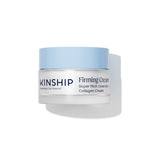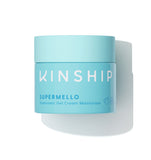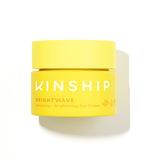Knowing exactly how much moisturizer to use is essential for maintaining skin hydration, supporting your skin barrier, and ensuring a healthy barrier function.
Many people wonder, "How much facial moisturizer should I use?" or "How much moisturizer should I put on my face?"
Getting the right amount is key, as using too much product can lead to clogged pores and a greasy feel, while too little can leave skin feeling dry and tight.
How much skincare product to use varies depending on your skin type and environmental conditions.
This guide will explain the importance of using the recommended amount of moisturizer, how it varies based on different skin types, application tips, and more.

Understanding Your Skin Type
Knowing your skin type is the first step to determining how much product to use.
Different skin types have different needs, and applying the right amount can significantly improve your skin's health and appearance.
Oily Skin
Oily skin produces excess oil, leading to a shiny appearance and larger pores.
People with oily skin may feel that their skin is always greasy, particularly in the T-zone (forehead, nose, and chin).
This type of skin is prone to acne and breakouts.
A nickel-sized dollop of a gel-based moisturizer, like our Supermello Gel Cream Moisturizer, is often enough. Using a foaming cleanser as part of your daily skin care routine order can help remove oily residue and prep your skin for hydration.
Using too little can cause moisture loss, while too much product can feel heavy or cause excess oil.
Dry Skin
Dry skin lacks natural oils and moisture, causing it to feel tight, rough, and flaky. It may have a dull appearance and is prone to fine lines and signs of aging.
Dry skin often feels uncomfortable and can be more sensitive to environmental factors like wind and cold weather.
If you have dry skin, use a dime-sized amount of a rich, cream-based moisturizer with hydrating ingredients like hyaluronic acid.
This helps to lock in moisture and combat moisture loss from environmental stressors. For nighttime use, opt for a face moisturizer to deeply hydrate your entire face.
Combination Skin
Combination skin has both oily and dry areas. For example, people with this unique skin type may have an oily T-zone, but dry cheeks.
Caring for combination skin can be extra challenging because it requires a balanced approach to address both the oily and dry areas.
Use a quarter-sized amount of a moisturizer that hydrates without leaving an oily residue.
Sensitive Skin
Sensitive skin is easily irritated and prone to feeling like your moisturizer is burning your face all of a sudden. It can react to potential irritants in products, which can potentially lead to discomfort.
Use fragrance-free formulas with soothing, hypoallergenic ingredients.
Apply two to three drops to avoid overwhelming your skin. Gently massage across your whole face, then gently pat for absorption.
Normal Skin
This skin type is the least problematic, and a dime-sized amount of lightweight moisturizer works well.
Normal skin is well-balanced, neither too oily nor too dry. It has a smooth texture, with small pores and a healthy complexion.
Maintain a consistent skincare routine with hydrating, water-based products.
Recommended Products
The General Rule for Moisturizer Application
Moisturizer is a topical product that hydrates and protects the skin, but you may think of how much moisturizer to apply regardless of skin type.
If you've ever wondered "How many skincare products should you use on your face?", remember that using the right amount of each product is as important as the products themselves.
Typically, a nickel-sized dollop of moisturizer is effective for most skin types. This guideline can vary, however, depending on factors like skin type, product consistency, and your skincare routine.
For example, those with oily skin may find they need to use less moisturizer than those with dry skin, and a thicker cream should generally be used more sparingly than a lightweight lotion.
Applying the right amount will help you avoid common skincare issues and maintain a balanced, hydrated complexion.
For moisturizers, a dime-sized amount works for most skin types; adjust if you have dry skin or acne-prone skin. Always apply to your entire face to ensure no areas are missed.
How to Apply Moisturizer Correctly

Knowing how much skincare to use is just as important as using the right amount.
Proper application ensures that your skin absorbs the product efficiently—maximizing its benefits. The following tips illustrate how to apply moisturizer properly.
- Cleanse Your Skin
Start with a clean face. Use a gentle cleanser, like our Naked Papaya Gentle Enzyme Cleanser, to remove dirt, oil, and makeup. Pat your face dry with a soft towel, leaving a thin layer of moisture.
- Apply to Slightly Damp Skin
This is why you have to cleanse your face first. Slightly damp skin helps the moisturizer absorb better.
- Use Gentle, Upward Strokes
Start from your neck and work your way up to your forehead. This technique helps lift the skin and promotes better absorption. Also, avoid tugging or pulling on your skin.
- Avoid the Eye Area
Unless your moisturizer is specifically formulated for the delicate skin around the eyes, avoid this area. Use an eye cream for your eyes instead.
- Layering with Other Products
For optimal results, you can layer your moisturizer with other skincare products like serums and sunscreen. Apply the thinnest consistency first, followed by thicker products.
Apply additional sunscreen every two hours during prolonged sun exposure.
For nighttime use, opt for a face moisturizer to hydrate and protect against environmental conditions that may damage your skin barrier.
NOTE: Apply moisturizer to your neck as well.

Adjusting for Seasons and Climate
Different weather conditions can influence your skin’s moisture needs.
Proper application techniques and adjusting for environmental factors will ensure your skin stays hydrated and healthy year-round.
- During Summer: When it is hot and humid, opt for lightweight, oil-free lotions or gels to avoid feeling greasy.
- In Winter: During cold and dry months, add thicker creams or ointments in your winter skincare routine to provide extra hydration and combat dry winter air.
How to Tell If You Are Using the Right Amount of Moisturizer
Finding the right balance with your moisturizer is crucial.
Over-moisturizing can lead to greasy skin, clogged pores, and breakouts.
Too much moisturizer can signal your skin to produce more oil, worsening the problem, especially if you have oily skin.
To adjust, use less, moisturize once daily, and switch to a lighter product like Kinship’s Supermello Hyaluronic Gel Cream Moisturizer.
Under-moisturizing results in dryness, tightness, and irritation.
Without adequate moisture, your skin can look dull and lackluster.
Use a bit more moisturizer to ensure your skin gets enough hydration. Also, moisturize twice daily, and use a richer or more emollient product.
Special Considerations for Different Areas of the Body
While the face often gets most of the spotlight due to its visibility and sensitivity, do not overlook the rest of the body.
Different regions, from your elbows and knees to your hands and feet, demand specific care and hydration to maintain their health and radiance.
Facial Skin vs. Body Skin
The skin on your face is significantly different from the skin on your body. Facial skin is thinner, more delicate, and contains more oil glands.
Therefore, it requires a different type of moisturizer compared to your body.
For your face, use lighter, non-comedogenic formulations to avoid clogging pores and causing breakouts.
Kinship’s moisturizers are designed specifically for the face and offer hydration without heaviness.
Targeting Dry Areas
Some body areas tend to be drier than others. Pay extra attention to your elbows, knees, hands, and feet—they need moisturizer, too.
- Elbows. These often become rough and dry. Use a thick, emollient-rich cream or body butter.
- Knees. Similar to elbows, knees require extra hydration. Apply a generous amount of moisturizer after showering.
- Hands. Frequent handwashing can lead to dryness. Apply hand cream regularly throughout the day, especially during winter.
- Feet. Feet, especially the heels, can become very dry and cracked. To repair and protect the skin, apply specialized moisturizer creams to these areas, especially before bed.
Using the right type of moisturizer for each area of your body ensures that your skin remains hydrated, healthy, and comfortable.
Frequently Asked Questions (FAQs)
Here are answers to common questions about how much moisturizer to use.
How Often Should You Moisturize Your Face?
It is generally recommended to moisturize your face twice daily—morning and night.
However, depending on your skin type and environment, oily skin might need less frequent application, while dry skin will benefit from consistent hydration.
What Happens If You Do Not Use Moisturizer?
Skipping moisturizer can lead to dry, flaky, and sensitive skin. It can also accelerate aging, dull your complexion, and reduce your skin's natural protection.
Regular use of moisturizer helps maintain hydration and protects against environmental damage.
How to Know if Moisturizer Is Working?
Your moisturizer is working if your skin feels hydrated and comfortable, not oily or slippery. It should relieve tightness and leave your skin smooth.
Effective moisturizers also integrate well with other skincare products without causing irritation.
Key Takeaways on How Much Moisturizer Should I Use

Everyone's skin is unique, so what works for one person might not work for another. However, finding the right amount of moisturizer to use is crucial for healthy, hydrated skin.
Here are the most important points to remember from this article.
- Know your skin type. This will help you choose the right moisturizer and determine the appropriate amount.
- Less is often more. Start with a pea-sized amount and adjust as needed. Too much can clog pores.
- Listen to your skin. If it feels hydrated but not greasy, you are using the right amount. Adjust if it feels too oily or remains dry and tight.
- Experiment. Do not be afraid to try different moisturizers and application methods to find what works best for you.
- Other parts of your body need moisturizer, too. Use body lotion for your body and a facial moisturizer for your face. Do not forget elbows, knees, hands, and feet.
Most people find that using the recommended amount of skincare products helps maintain healthy skin.
If you’re unsure how much skincare to use, consult with a board-certified dermatologist for guidance tailored to your specific product and unique skin needs.
Remember, consistency is key. Moisturize twice daily for best results, but adjust based on your skin's needs.
Recommended Products



